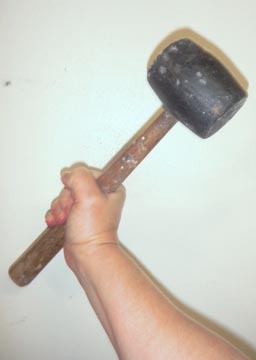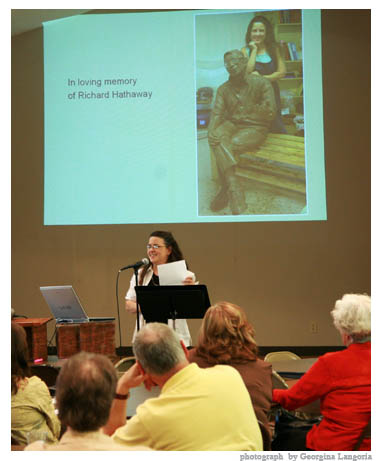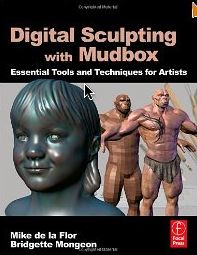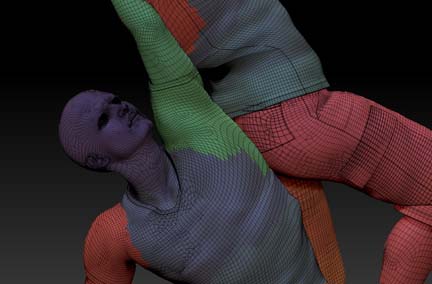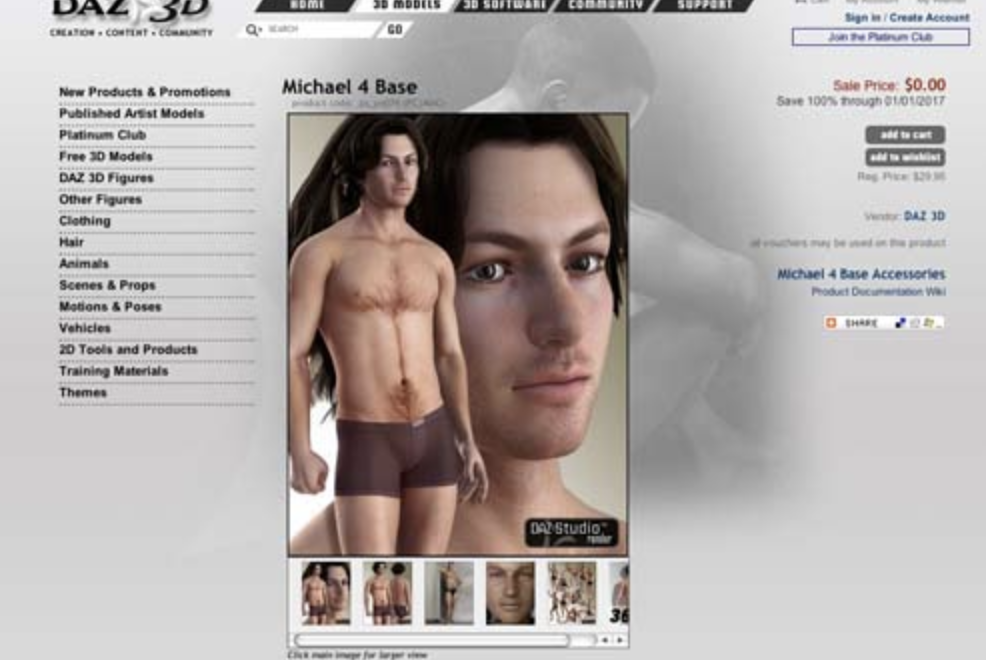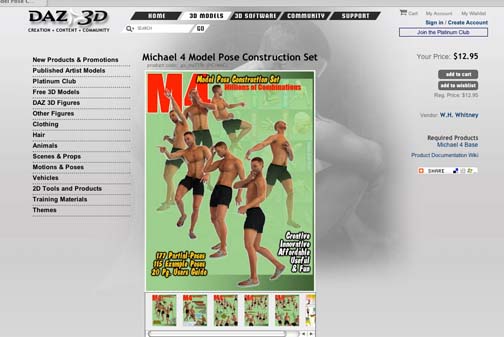Technology
Is It Easy For You To Identify And Judge 3-Dimensional Shapes, Distances And Proportions On a Computer Screen? An Interview Cont.
9. Is it easy for you to identify and judge 3-dimensional shapes,
distances and proportions on a computer screen?
1. The hardest part, and we mention this in the book is the size of the sculpture. If I am working on a maquette in the studio, I know if I enlarge that maquette 500% I will not have as much detail as I need. So what is the actual size of a virtual piece of art? What happens with the translation from digital work a the size I have created, to the physical size I need output?
2. I would love to see calipers in the digital programs. Something that resembled more traditional calipers in a digital environment.
3. I also was very confused when I first worked in mudbox with perspective view and orthographic view.
4. There is also a cliche with Macs that if you hit the some keys in a certain order your sculpture flips. This is not just a problem with Mudbox or Zbrush but many graphics programs. This freaked me out, and I wish someone could solve this.
5. It is easier for me to judge 3d space now than in the beginning. Though when symmetry begins to act funky, and I know It is some sort of driver error, I get a bit frustrated. I love being able to spin around a sculpture.
6. I do wish that I had more access to my photographs. The one solution I have found for this is Macs Photstickies.
By the way, question number 8 was
8. Which medium is more comofortable for you to use?
( see other posts)
This is an interview of 10 questions by Mathias Herbster of FH Vorarlberg University in Austria directed to Sculptor Bridgette Mongeon about the comparison of digital and traditional sculpture.
______________________________________________________________

Sculptor, Writer and Speaker
Bridgette Mongeon is a sculptor, writer, illustrator and educator as well as a public speaker.
Her blog can be found at https://creativesculpture.com.
She is also the owner and creator of the God’s Word Collectible Sculpture series
Follow the artists on twitter twitter.com/Sculptorwriter twitter.com/creategodsword
Facebook http://www.facebook.com/bridgette.mongeon
Listen to The Creative Christian Podcast or the Inspiration/Generation Podcast Click on Podcast Host Bios for a list of all podcasts.
Listen to the Art and Technology Podcast
What Do You Miss In The Digital Sculpting Technology? An Interview Cont.
7. What do you miss in the digital sculpting technology?
As mentioned before, ease and affordability of output. Ease of quickly sculpting without having to worry about topology. As I have mentioned before, retopologizing is actually the holy grail of this process. However, I have seen this change over the last year, and it is quickly becoming a non issue. I look forward to exploring these in the up and coming months.
At first I might have missed much about traditional and I still will continue in it. However, one of the main factors that pushed me in the direction of this exploration was damage to my hand, I could no longer hold a sculpting tool. Years of pushing and pulling clay, pounding with tools or scraping had taken its toll. I have since had surgery and am happy to say I have my hand back, but the advances and exploration of this digital technology will be a very important element of creating late in life, when my body may rise up again in revolt. It has extended my tool set and capabilities as a sculptor far beyond anything I could have imagined for myself.
This is an interview of 10 questions by Mathias Herbster of FH Vorarlberg University in Austria directed to Sculptor Bridgette Mongeon about the comparison of digital and traditional sculpture.
______________________________________________________________
Bridgette Mongeon is a sculptor, writer, illustrator and educator as well as a public speaker.
Her blog can be found at https://creativesculpture.com.
She is also the owner and creator of the God’s Word Collectible Sculpture series
Follow the artists on twitter twitter.com/Sculptorwritertwitter.com/creategodsword
Facebook http://www.facebook.com/bridgette.mongeon
Listen to The Creative Christian Podcast or the Inspiration/Generation Podcast Click on Podcast Host Bios for a list of all podcasts.
Listen to the Art and Technology Podcast
Which Medium Do You Think Is More Flexible, Digital or Analog Clay? An Austrian Student Interview Cont.
2. Which medium do you think is more flexible, digital or analog clay?
I have described a bit of this in a previous post, however, in defense of digital sculpting, the tools that are available intrigues me. For example, sculpting symmetrically, though no person is symmetrical, I can change that at the end. But in digital I don’t have to sculpt two eyes, or two ears, etc. When I can shorten the amount of time of getting the shape and instead focus on the detail the technical process allows me more time for creativity.
By far the most hindering part of the digital process is the output. There are still a few factors that interfere with my process in this area. One is cost, and the other is the medium, also the build envelope or size. I’m finishing a bust in traditional clay right now, but I would much rather have created it digitally. However, my resources for out put would have been milling in foam, a good armature for larger pieces, but I would have still had to do the details again, and I do not like the stiff look that a piece of foam covered in clay has.

I could mill it out in stone; I must say I anxious to have a project where I can explore this more. All my life I have sculpted in clay, concrete, bronze or pourable mediums. Now with digital milling in stone I can extend my tool set to “stone carver”. With the Digital Stone project, I can create artwork in this medium, as well. This excites me to no end. When I think of the possibilities I also consider the many projects I have given up over the years not having this skill set.
I also love the idea of doing more architectural sculpting work using the digital tools. Creating a finial and being to enlarge it 20% or anything in steps of enlargement is huge. There is no price that can be put on that.
However, digital printing in any other medium is not a viable option, either because of the build envelope or the cost.
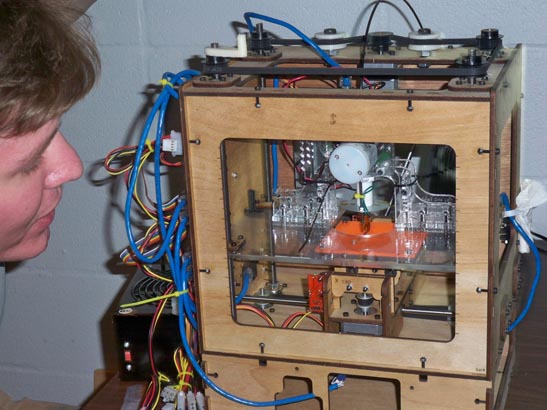
Im intrigued with the research at Solheim Additive Manufacturing Laboratory in the Mechanical Engineering Department on the University of Washington campus. If only I could create in the computer and then digitally print out my form in clay in my own studio, like they are doing at this lab. I think this would be a viable resource for me. I know that the open source “free” 3d printers like Rep Rap or maker bot have some attachments to digitally print in clay, and I’m waiting to see how these evolve.
I think another resources is materialize by .mGX for going directly to bronze, though very expensive. I have visions of using them on an intricate piece similar to Alfred Gilbert’s Virgin Mary or St. Michael. Pieces that would be a nightmare to recreate in a triditional bronze process but could easily be done with .MGX.
The very near future will drastically change the way I work. As many of the patents have ended on 3D printing, I believe you will begin to see a change in the cost factor and availability of home 3D printers. I still may be limited by the build size, unless, of course, I can figure out how to change a machine to accommodate my needs. I’m not sure I am that mechanically savvy.
As I write this, I find an aching. To go from screen to finished project without touching it leaves a hole inside of me. I am afraid I will not be able to “feel” the emotion of the piece unless I touch it. Oh, this is a strange thought.
Though looking at the quick sketches in my Mudbox video I can feel the emotion without touch. Will it feel the same digitally printed?
Remember, I am still a traditional artist. I get paid for a tangible piece of art. I need to get the sculptures out of the computer. I must base my choices on that final output.
This is an interview of 10 questions by Mathias Herbster of FH Vorarlberg University in Austria directed to Sculptor Bridgette Mongeon about the comparison of digital and traditional sculpture.
_____________________________________________________________________________

-Sculptor, Writer and Speaker
Bridgette Mongeon is a sculptor, writer, illustrator and educator as well as a public speaker.
Her blog can be found at https://creativesculpture.com.
She is also the owner and creator of the God’s Word Collectible Sculpture series
Follow the artists on twitter twitter.com/Sculptorwriter twitter.com/creategodsword
Facebook http://www.facebook.com/bridgette.mongeon
Listen to The Creative Christian Podcast or the Inspiration/Generation Podcast Click on Podcast Host Bios for a list of all podcasts.
Listen to the Art and Technology Podcast
What Makes Sculpting In Clay Appealing To You? An Austrian Student Interview Cont.
1. What makes sculpting in clay appealing to you?
I am a tactile person. I love the feel of clay in my hands, the softness of wet clay out of the bag allowing me to quickly rough in the general shape, the leather hard stage providing the perfect texture for carving in intricate details. The smell of earth, the sound of the water as it is sucked into dry clay in a cup— regenerating it into a malleable medium.
Working in this medium for over 25 years there is more. My brain has developed synapsis that are strictly 3 dimensional. I can quickly rough in a figure and gesture, bringing emotion to an object in clay, much faster than I can in a 2d sketch. In fact, I have noticed that my brain misfires, skips, or bluntly—farts when I am trying to bring thoughts from my brain into two dimensions, though I have continued to sketch my entire life, working in clay or a 3D form helps me to express that creativity quicker. My study of emotion in art, especially facial expression and psychology and science behind that, is exhibited in my sculptural forms and my creations of posthumous sculptures. I have trained myself in the precision of finding the emotion and transferring it to the clay. I’m not sure if this transpires in digital form. It probably does, and I do my best to explain it in my lectures, but it is a very abstruse, imperceptible process.
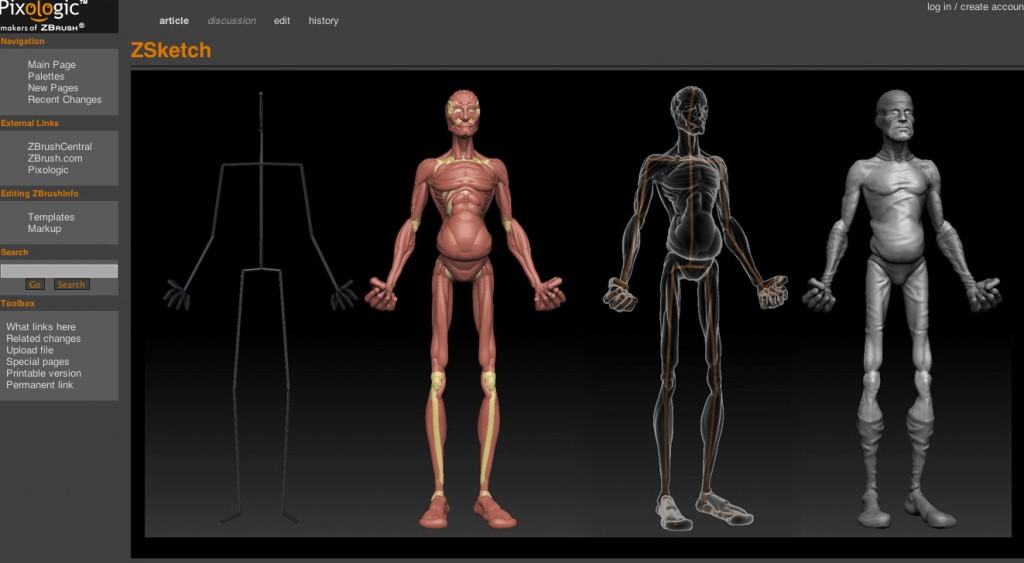
I must say that I do love the immediacy of the medium. I love being able to quickly squeeze and pinch or pull a shape out of a blob. This was probably my most frustrating aspect of digital sculpting, but is quickly changing. I hated having to be bound by the geometry under a piece, it still pisses me off from time to time. Zbrush’s zsketch is more in tuned to my traditional process though I am still butting up against geometry every now and then. I would say the same with being able to pose or move a piece. For me, doing this digitally (Zbrush, Mudbox) is time consuming and leaves me fumbling. I want to play with the form before finalizing it, and I do not feel as comfortable digitally with that as I would like. Some say the geometry is the armature. To me, that is a poor analogy, it is more like grit that is caught in my traditional clay and totally irritating me as I try to dance my hand over it.
This is an interview of 10 questions by Mathias Herbster of FH Vorarlberg University in Austria directed to Sculptor Bridgette Mongeon about the comparison of digital and traditional sculpture.
_____________________________________________________________________________

Sculptor, Writer and Speaker
Bridgette Mongeon is a sculptor, writer, illustrator and educator as well as a public speaker.
Her blog can be found at https://creativesculpture.com.
She is also the owner and creator of the God’s Word Collectible Sculpture series
Follow the artists on twitter twitter.com/Sculptorwriter twitter.com/creategodsword
Facebook http://www.facebook.com/bridgette.mongeon
Listen to The Creative Christian Podcast or the Inspiration/Generation Podcast Click on Podcast Host Bios for a list of all podcasts.
Listen to the Art and Technology Podcast
An Austrian Student Interviews Me On Comparison Of Digital And Traditional Sculpture
I have worked hard over the last few years exploring the digital technology and trying to bridge the gap between digital sculpture and traditional sculpture. I have explored the process in my book Digital Sculpting inMudbox Essential Tools and Techniques for artists, with the Art and Technology podcasts, and in lectures that I have presented to organizations and institutions. Should your institution want me to come and talk about these topics, please feel free to contact me with the details.
My graduate studies and the writing of my first novel distracted me for the past year, but I’m looking forward to getting back to the topics surrounding digital technology. The technology continues to change. I really want to write a book about the technology and the processes. It would be wonderful to focus on the incredbiel artwork stemming from the use of this technology. I see it as a guidebook of resources, as well. There are also many new issues surrounding the use of digital technology that need to be addressed. I’m still looking for a publisher that will get behind the need for this information.
Today, I woke and found an e-mail in my in box from a student from FH Vorarlberg University in Austria. Mathias has the same desire and direction and focus that I have with sculpting/digitally and traditionally and wants to interview me. I’m flattered, but more than that I feel comforted. In my life, it is extremely important to pass on information and help others. I find it in all aspects of my life— a driving force. To see that my podcasts, articles, books and desire have reached half way around the world to someone else with the same passion and direction, is inspiring. I thought it would be interesting to answer these questions publicly on my forum.
_____________________________________________________________________________

Sculptor, Writer and Speaker
Bridgette Mongeon is a sculptor, writer, illustrator and educator as well as a public speaker.
Her blog can be found at https://creativesculpture.com.
She is also the owner and creator of the God’s Word Collectible Sculpture series
Follow the artists on twitter twitter.com/Sculptorwriter twitter.com/creategodsword
Facebook http://www.facebook.com/bridgette.mongeon
Listen to The Creative Christian Podcast or the Inspiration/Generation Podcast Click on Podcast Host Bios for a list of all podcasts.
Listen to the Art and Technology Podcast
“Browsing The Archives?”

A fellow graduate classmate posted that “browsing the archives” of a blog is like “walking down memory lane”, she wondered if that would become a new saying. As I “brows the archives” of my life, I realize I don’t write just because I love to write, I write because I have a terrible memory. Documenting helps me to recall. In light of that, here are some of my blogs and recollections.
Creative Endeavors Blog—Began posting May 2005— 6 years of blogging
This blog documents my creative process in many different areas—sculpting, 3D, writing, teaching and marketing in the arts.
I love reading about all of my projects, and I especially love that this blog documents our creation of the new studio space. A hug change from my old place
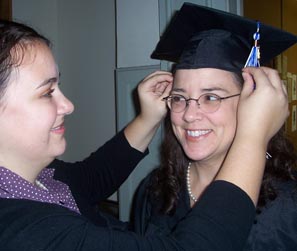
going back to school – finishing my
undergraduate at Vermont College and my
terminal degree at Goddard.
Perpetual Learner Blog – Began posting in March 2005-6 years of blogging
I began this blog when I decided to go back to undergraduate school as a nontraditional student. Nontraditional basically means—your old. The blog started in March of 2005 and documents the entire process of undergraduate school at Vermont College, and then graduate school at Goddard. I will finish graduate school in January of 2012. I have no idea where this blog will go from there. I am, however, a perpetual learner, so I doubt it will stop.

Richard Hathaway Blog– Began in March of 2006
This blog documents the sculptural process of creating a life-size bronze of Professor Richard Hathaway for the T.W. Wood Gallery in Vermont . The sculpture was installed in Vermont a few years back. I visit the bronze often and people send pictures and memories, which I continue to post.
The Newsboy PRE BLOG- If only I had known about blogs then, started 2004- 8 months. In 2020 these html blog pages where merged into this blog. Just follow the category Newsboy.
This is a documentation of the creating of a life-size newsboy sculpture for the Texas Press Association. The edition is an edition of 10, so when one is sold I document where the additional pieces in the sculpture has gone. If only there were blogs back then or I would have known about them. It was murder trying to create html pages for each of these posts, with links that worked to the next post.
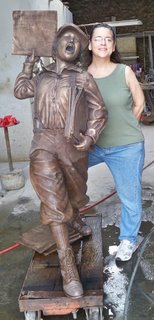
newsboy sculpture was
documented on my website
prior to blogging. I love
the educational element that
I added. Materials for teachers
and students to use. I would
love to do more blogging
that can be used in education
either with art or travel.
What is next?
Blogging gives me the opportunity to invite individuals from all over the world to view my work in my studio. When a project comes up, I’m always thinking about blogging. Perhaps it is a personal commissions and the family that is around the world can watch it being created. I’d love to do something for a school or program that would incorporate my blogging and sculpting as an education for young people, especially if I could have the interaction of the students. Now that would be the icing on the cake. If you have a project and want to get lots of people involved in the creating of it, give me a call, we can create a blog especially for your project documenting the entire thing.
I’m not sure who reads the blogs. I try to have helpful information in them. Will there be more blogs? Yes, actually I just purchased another domain. I’m going to start a blog for just my writing projects. Thanks for sharing in my own walk in life. It is my goal to help and encourage as many people as I can along the way.
The act of putting pen to paper encourages pause for thought,
this in turn makes us think more deeply about life,
which helps us regain our equilibrium. ~Norbet Platt
_____________________________________________________________________________

Sculptor, Writer and Speaker
Bridgette Mongeon is a sculptor, writer, illustrator and educator as well as a public speaker.
Her blog can be found at https://creativesculpture.com.
She is also the owner and creator of the God’s Word Collectible Sculpture series
Follow the artists on twitter twitter.com/Sculptorwriter twitter.com/creategodsword
Facebook http://www.facebook.com/bridgette.mongeon
Listen to The Creative Christian Podcast or the Inspiration/Generation Podcast Click on Podcast Host Bios for a list of all podcasts.
Listen to the Art and Technology Podcast
Creating An Author’s Page At Amazon For The Mudbox Book
For those of you who don’t know, I coauthored a book with my husband called Digital Sculpting in Mudbox: Essential Tools and Techniques. Most software books can become dated, but this book talks about things that others do not. Let me tell you about the two chapters that I am proud of. I should be proud, I wrote them and labored over them. One chapter brings a person through the entire process of sculpting a portrait digitally. Yes, I have taken my traditional process and expressed it digitally. So this book will help with that. You can use it if you are using Mudbox or the competition Zbrush. It will also help if you are a traditional sculptor. The other chapter talks about digital printing, milling and scanning. This is huge and I would love to do an entire book on this subject, just in case there should be a publisher that is interested. For those of you who don’t know, you can now print things in 3d. Yes, you can create objects in the computer and print them. Kind of like the Star trek replicator. The difficulty is, that not many artist know the processes that are available for this sort of thing. That is what this chapter is about. Breaking it down into bite sized pieces and also offering the reader a list of resources. In my opinion, this information is worth purchasing the book. You just can’t find it compiled anywhere else.
If you want to see my authors page just click on this Amazon link to the book and then on my name.
We have also put together a website and forums for this book. It is located at digitalsculpting.net Be sure to also check out the podcasts on art and technology at the website.
The Final Results of The Presentation Using Daz, Poser, Zbrush And Photoshop.
After two days of Daz, Poser, Zbrush and Photoshop I finally have some images ready to send to the client. Having two figures increases the cost. So, I created an alternate version of one figure. Curious to hear what others think.

from eye level, as it sits on the table is important.
Bridgette Mongeon is a sculptor, writer, illustrator and educator as well as a public speaker.
Her blog can be found at https://creativesculpture.com.
She is also the owner and creator of the God’s Word Collectible Sculpture series
Follow the artists on twitter twitter.com/Sculptorwriter twitter.com/creategodsword
Facebook http://www.facebook.com/bridgette.mongeon
Listen to The Creative Christian Podcast or the Inspiration/Generation Podcast Click on Podcast Host Bios for a list of all podcasts.
Listen to the Art and Technology Podcast
Working Through Presentations- Daz-Poser-Zbrush-Part 2
As I stated in my last post. I am trying to do a presentation for a client. We are working on the design for a small bronze sculpture. I wondered what would happen if I brought my daz model into zbrush. The most I could hope for is that it would take it out of the color version of Poser and perhaps I could display it in clay, add a base and some other elements. To my surprise it came in quite nicely. The process was simple I made the Poser file as an obj. and imported into zbrush as a subtool. And for a greater excitement I found the mesh was not that bad. FYI a good mesh for sculpting is made up of quads without triangles. This mesh is not that bad and I might even be able to sculpt on it to give it more movement for the presentation. Of course once this is done I have to go downstairs and work in the real clay, but for now this really helps the client and I to be on the same page. Now, back to the drawing board as I really want to sculpt on this and perhaps even do one or two other designs for the client to see.
Bridgette Mongeon is a sculptor, writer, illustrator and educator as well as a public speaker.
Her blog can be found at https://creativesculpture.com.
She is also the owner and creator of the God’s Word Collectible Sculpture series
Follow the artists on twitter twitter.com/Sculptorwriter twitter.com/creategodsword
Facebook http://www.facebook.com/bridgette.mongeon
Listen to The Creative Christian Podcast or the Inspiration/Generation Podcast Click on Podcast Host Bios for a list of all podcasts.
Listen to the Art and Technology Podcast
Working Through Presentations- Daz-Poser-Zbrush-Part 1
Poser– In my life as a sculptor I rarely do to show clients, not hand drawn sketches. But over the past years I have begun utilizing 3D resources for presentations. I have mentioned this before in my blog and also talked about it in some of my online videos. I am presently trying to come up with a design for a figurine of a person playing ultimate Frisbee.
Of course the first place I turn to when I am creating these type of presentations, if I don’t already have what I need, is Daz. I liked the Michael model as he had the youthful appearance I was after. Plus he also came with many different things. And to discover he was free was a plus. Of course I also invested into his clothes, as I felt these would give me the closest look to an Ultimate players clothes. The model posing set for this was definitely worth it as it comes with individual arm, and leg poses. Of course if you have worked with Poser you can pose the model yourself, but it is much easier to do that if the model is close to what you want, then you can tweak it as necessary.
I must say my Poser 7 was giving me a little bit of a trouble if I tried to pose these two characters individually and then merge them-crash after crash. I was much better to pose one then bring another into the scene in neutral position to pose that one. I should probably choose to use the free daz program, and I have downloaded it but I am quicker at Poser. I am not sure that upgrading to Poser 8 will make much difference for me.
I am working with a couple of different designs with this piece. I really want to get the main character off of the ground. Flight seems to be such a big part of ultimate. However, flight is hard to do when you are working with bronze. Sure, I can have him coming up into flight with a foot touching the ground. But that is something that must be engineered. Depending on the size and weight of the piece it can be a nightmare.
After watching hours of ultimate video and stopping and rewinding, I decided I could have my main character “secured” in flight to another person. Especially if they were kind of body slamming. So this is the beginning of one design using Poser. I know my client may like to have just the one figure in the piece, but I think having two really adds the action to the sculpture.
I’m not sure why Poser is giving me the “banding” on the pants. But I have future plans for this presentation before the client sees it. Stay tuned- more cool stuff coming in the next posts.
Her blog can be found at https://creativesculpture.com.
She is also the owner and creator of the God’s Word Collectible Sculpture series
Follow the artists on twitter twitter.com/Sculptorwriter twitter.com/creategodsword
Facebook http://www.facebook.com/bridgette.mongeon
Listen to The Creative Christian Podcast or the Inspiration/Generation Podcast Click on Podcast Host Bios for a list of all podcasts.
Listen to the Art and Technology Podcast

